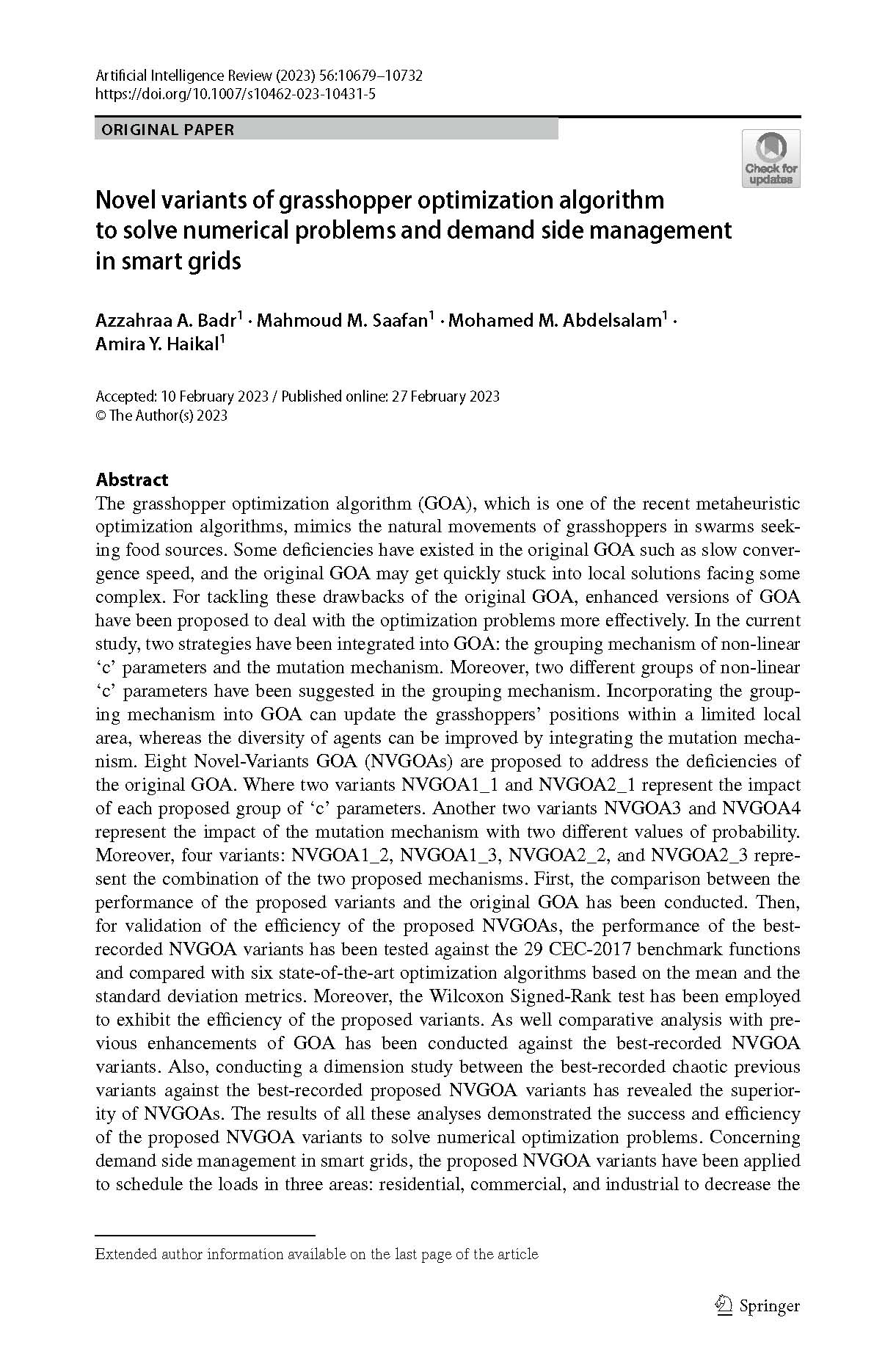Novel variants of grasshopper optimization algorithm to solve numerical problems and demand side management in smart grids
Article Ecrit par: Abdelsalam, Mohamed M. ; Saafan, Mahmoud M. ; Haikal, Amira Y. ; Badr, Azzahraa A. ;
Résumé: The grasshopper optimization algorithm (GOA), which is one of the recent metaheuristic optimization algorithms, mimics the natural movements of grasshoppers in swarms seeking food sources. Some deficiencies have existed in the original GOA such as slow convergence speed, and the original GOA may get quickly stuck into local solutions facing some complex. For tackling these drawbacks of the original GOA, enhanced versions of GOA have been proposed to deal with the optimization problems more effectively. In the current study, two strategies have been integrated into GOA: the grouping mechanism of non-linear 'c' parameters and the mutation mechanism. Moreover, two different groups of non-linear 'c' parameters have been suggested in the grouping mechanism. Incorporating the grouping mechanism into GOA can update the grasshoppers' positions within a limited local area, whereas the diversity of agents can be improved by integrating the mutation mechanism. Eight Novel-Variants GOA (NVGOAs) are proposed to address the deficiencies of the original GOA. Where two variants NVGOA1_1 and NVGOA2_1 represent the impact of each proposed group of 'c' parameters. Another two variants NVGOA3 and NVGOA4 represent the impact of the mutation mechanism with two different values of probability. Moreover, four variants: NVGOA1_2, NVGOA1_3, NVGOA2_2, and NVGOA2_3 represent the combination of the two proposed mechanisms. First, the comparison between the performance of the proposed variants and the original GOA has been conducted. Then, for validation of the efficiency of the proposed NVGOAs, the performance of the best-recorded NVGOA variants has been tested against the 29 CEC-2017 benchmark functions and compared with six state-of-the-art optimization algorithms based on the mean and the standard deviation metrics. Moreover, the Wilcoxon Signed-Rank test has been employed to exhibit the efficiency of the proposed variants. As well comparative analysis with previous enhancements of GOA has been conducted against the best-recorded NVGOA variants. Also, conducting a dimension study between the best-recorded chaotic previous variants against the best-recorded proposed NVGOA variants has revealed the superiority of NVGOAs. The results of all these analyses demonstrated the success and efficiency of the proposed NVGOA variants to solve numerical optimization problems. Concerning demand side management in smart grids, the proposed NVGOA variants have been applied to schedule the loads in three areas: residential, commercial, and industrial to decrease the daily operating costs and peak demand. The results show that the peak demand is reduced by 23.9%, 17.6%, and 9.2% in residential areas, commercial areas, and industrial areas respectively. Also, the operating cost decreased by 7.25%, 9.2%, and 18.89% in residential, commercial, and industrial areas, respectively. Finally, the overall results show that the proposed NVGOA algorithms are effective solutions to address the flaws of the original version of GOA and can get high-quality solutions for different optimization problems.
Langue:
Anglais
Thème
Informatique
Mots clés:
Optimization
metaheuristics
Grasshopper optimization algorithm
Novel Variants
Smart electrical grid
Demand side management

